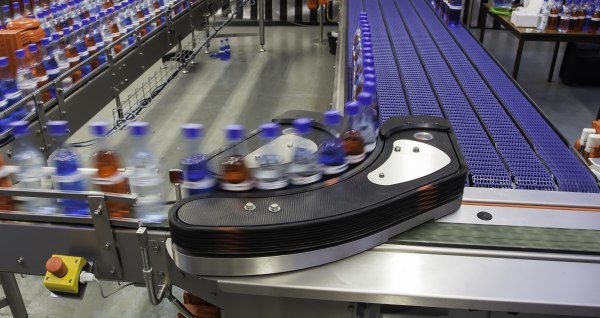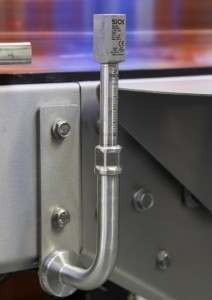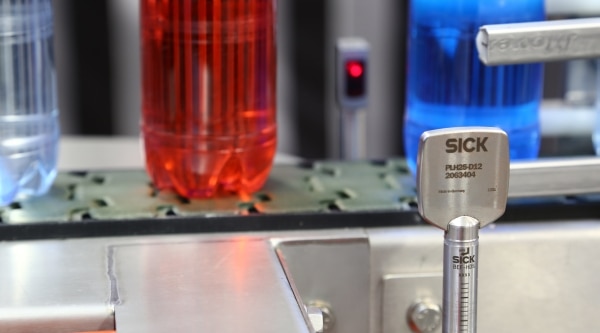With the new horizontal accumulator the Netherlands based conveyor system manufacturer Polyketting is bringing about a miniature revolution in the industry. Now even bottles, other totes and packages with complex instable bottom structures can be accumulated without any problems. The in- and out feed units do not only guide the products, but guarantee also that the process runs smoothly. As a result, the number of faults stays at zero, says Commercial Director Henk-Jan Visser. SICK's W4 Inox miniature photoelectric sensors are used to monitor these processes, as well as for other purposes.
 Optimizing efficiency is the number one priority in the packaging lines of the food and beverage industry. If even one machine experiences a fault, the entire system can be brought to a halt in one fell swoop, which naturally impacts on the profitability of the production line. The placement of strategic buffer zones at specific points in the production line can keep smaller machine failures contained so that they do not disturb the overall process. While the operator resolves the fault on the failed machine, Polyketting's solutions temporarily collect the products building up on the line as the production process continues. All machines preceding the point of failure can continue to run as normal thanks to these buffer solutions.
Optimizing efficiency is the number one priority in the packaging lines of the food and beverage industry. If even one machine experiences a fault, the entire system can be brought to a halt in one fell swoop, which naturally impacts on the profitability of the production line. The placement of strategic buffer zones at specific points in the production line can keep smaller machine failures contained so that they do not disturb the overall process. While the operator resolves the fault on the failed machine, Polyketting's solutions temporarily collect the products building up on the line as the production process continues. All machines preceding the point of failure can continue to run as normal thanks to these buffer solutions.
The advantage of horizontal buffering
Polyketting not only offers smaller buffers using integrated intelligent controls integrated within the conveyor system, it also offers multi-track solutions which can buffer a large number of products both in- and off line. The multiple single-track solution off the line is the horizontal accumulator. Visser explains, In the 1990s, we were the first to introduce FIFO (First In First Out) accumulator to the market. The enormous advantage of this solution is the fact that it is completely flat. It doesn't divert the operator's attention away from the production process; they can concentrate completely on the main process and quickly resolve any faults. The First In First Out (FIFO) principle is another advantage of Polyketting's accumulator. The product that comes in first will leave first again. This is a really important aspect - especially in the food and beverage industry, where the greatest priority is placed on 100% traceability, Visser adds.
Residual risks excluded
In the development of a new horizontal accumulatorin 2012, Polyketting was able to improve even further on the quality of its already successful product. As Visser states, The accumulator now not only has a higher capacity (30,000 buffered products per hour as compared to the previous rate of 14,000), but also now has a unique grip chain, which we have applied for a patent for. This grip chain, which comes from our own R&D department, carefully manipulates the products without damaging them, while at the same time having a strong enough grip to transfer the products flawlessly. The accumulator can even handle packaging with challenging, asymmetrical bottoms, such as PET bottles, without problems. It performs its work with such precision and reliability that the risk of falling bottles has essentially be eliminated.
Praise for service from SICK
Polyketting relies almost entirely on SICK for the sensor technology in its buffer table and conveyor systems. As Dumore explains, SICK is the standard that is widely implemented on both the market and with customers. The photoelectric sensors function reliably, and SICK retailers are located all over the world. On top of that, SICK's customer service is well organized. Dumore praises the successful partnership. The consultants at SICK really think of everything. And if a problem does occur, they take care of it quickly - although serious problems hardly ever arise.
 W4 Inox miniature photoelectric sensors monitors the entry and removal of the products on the buffer table
W4 Inox miniature photoelectric sensors monitors the entry and removal of the products on the buffer table
Washdown-Design
 W4 Inox photoelectric sensor in washdown design[/caption] SICK recommended the W4 Inox miniature photoelectric sensor in washdown design for the new buffer table. According to Dumore, Our products meet high hygiene standards and are entirely comprised of stainless steel, which is essential in the food and drink industry. The photoelectric sensors also have to meet these requirements. The washdown design of the photoelectric sensors, cables, and installation systems is a vital advantage for our customers. Previously, dirt would always accumulate around the cables and installation materials of systems like these. The washdown design of these new parts means that after spraying them with the cleaning foam, they are clean without any residues or remaining contamination.
W4 Inox photoelectric sensor in washdown design[/caption] SICK recommended the W4 Inox miniature photoelectric sensor in washdown design for the new buffer table. According to Dumore, Our products meet high hygiene standards and are entirely comprised of stainless steel, which is essential in the food and drink industry. The photoelectric sensors also have to meet these requirements. The washdown design of the photoelectric sensors, cables, and installation systems is a vital advantage for our customers. Previously, dirt would always accumulate around the cables and installation materials of systems like these. The washdown design of these new parts means that after spraying them with the cleaning foam, they are clean without any residues or remaining contamination.
 W4 Inox miniatur photoelectric sensor[/caption] Dumore suggests that the reflectors that come with the sensors are also perfectly designed for the high demands within the system. Most reflectors need to be replaced sooner rather than later due to the heavy-duty spray of water from high-pressure cleaners, but the special products from SICK have a significantly longer service life.
W4 Inox miniatur photoelectric sensor[/caption] Dumore suggests that the reflectors that come with the sensors are also perfectly designed for the high demands within the system. Most reflectors need to be replaced sooner rather than later due to the heavy-duty spray of water from high-pressure cleaners, but the special products from SICK have a significantly longer service life.
- Product information: W4 Inox miniature photoelectric sensor
- Product portfolio: Miniature photoelectric sensors
- Customer Informations: Polyketting

